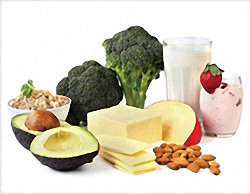- Fruits & Vegetables
- GMOs & Organics?
- Benefits of Grains
- What's a Carb?
- Low Carb Substitutes
- Proteins: Building Blocks
- Protein-Packed Breakfasts
- Meats: Keep it Lean
- Dairy Health Benefits
- Importance of Vitamin D
- Artificial Sweeteners
- Eating a Healthy Diet
- Fiber Sources & Benefits
- How Much Water?
- Example 2 Day Meal Plan
- Mediterranean Diet Pyramid
- Nutrition Facts Label
- Vitamins & Minerals
- U.S. Dietary Guidelines
benefits and sources of vitamin D
 |
When to Supplement with Vitamin D? |
||||||||||||||||||||||||||||||||||||||||||||||||||||||||||||||||||||||||
People at higher risk for vitamin D deficiency include those:
Low levels of vitamin D have been linked to higher incidence of many diseases, including diabetes, high blood pressure and certain cancers. In fact, a review of research conducted between 2001 through 2008 indicates a connection between vitamin D levels and the incidence of some cancers. It appears that the risk for certain cancers such as endometrial, renal and colon cancer may be reduced significantly if a person's vitamin D levels are maintained at 35-40ng/ml. Breast cancer and type I diabetes may be reduced by half if a woman's vitamin D levels are between 50-60ng/ml. Furthermore, it's estimated that up to 80% of type I diabetes may be preventable if blood levels of vitamin D are maintained at 50-55ng/ml. A simple blood test can help you know if you need to consider a vitamin D supplement. Most adults need 600 IU (international units) or 15 micrograms. Getting some sunshine and including a number of foods that are good sources of vitamin D (see chart below) will help you get the right amount, but to know for sure, you should talk to your physician about testing and, if necessary, ask for his/her help in selecting a supplement that is right for you.
Vitamin D: The Sunshine Vitamin makes for a Healthy Body Currently, vitamin D deficiency is being diagnosed at an alarming rate in the general public and research suggests a connection between low levels of vitamin D and type II diabetes. While it's not clear that low vitamin D can cause diabetes, it's a good idea to make sure you are getting outside to enjoy some sunshine! While you're there, run and play because there's no doubt that exercise helps build strong bones and can help ward off the risk of diseases such as diabetes as well!
Gorham ED, et al. Am J Prev Med. 2007;32:2:210-6
* IUs = International Units. |
|||||||||||||||||||||||||||||||||||||||||||||||||||||||||||||||||||||||||
H‑E‑B Health Care Services Notice of Privacy Practice | Texas State Board of Pharmacy | How to Dispose of Unused Medicines